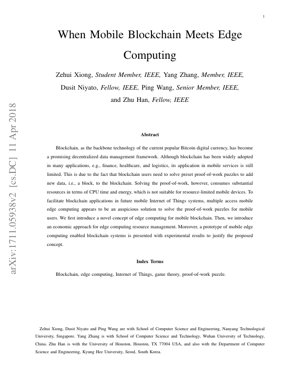Table of Contents
- 1. Introduction
- 2. Edge Computing for Mobile Blockchain
- 3. Economic Resource Management
- 4. Experimental Results
- 5. Technical Analysis
- 6. Code Implementation
- 7. Future Applications
- 8. References
1. Introduction
Blockchain serves as a decentralized public ledger for storing transaction records, overcoming limitations of centralized systems like single-point failures and security vulnerabilities. Data is structured as blocks in a linked list, replicated across the network to ensure integrity. Mining, involving proof-of-work (PoW) puzzles, is essential for adding new blocks but demands substantial computational resources, hindering adoption in resource-constrained mobile and IoT devices. Mobile edge computing (MEC) emerges as a solution by providing computing power at network edges, such as base stations, enabling efficient PoW offloading. This integration enhances blockchain robustness and offers incentives for mobile users through consensus rewards. However, economic challenges like pricing and resource allocation require optimization using game theory.
2. Edge Computing for Mobile Blockchain
Edge computing leverages local servers at mobile network edges to support low-latency applications, crucial for 5G networks. For blockchain, MEC allows mobile devices to offload PoW puzzles to edge servers, reducing energy consumption and improving participation.
2.1 Architecture Overview
The system comprises mobile miners, edge servers, and a blockchain network. Miners submit PoW tasks to edge servers via wireless links, and servers return solutions for block validation. This decentralized approach minimizes delays and enhances scalability.
2.2 Proof-of-Work Offloading
PoW involves finding a nonce that produces a hash below a target value: $H(block \| nonce) < target$. Offloading this to edge servers saves mobile resources, with the hash function computed as $H(x) = SHA256(x)$.
3. Economic Resource Management
An economic model optimizes resource allocation between edge providers and miners.
3.1 Game Theory Model
A Stackelberg game models interactions: the provider sets prices, and miners adjust computing demand. The provider's profit is $\pi_p = p \cdot d - C(d)$, where $p$ is price, $d$ is demand, and $C$ is cost. Miners maximize utility $U_m = R - p \cdot d$, with $R$ as block reward.
3.2 Pricing Mechanism
Dynamic pricing balances supply and demand, similar to techniques in wireless networks [9]. For instance, [10] uses pricing for cooperative communication, adapted here for computing resources.
4. Experimental Results
Experiments validate the proposed framework.
4.1 Performance Metrics
Key metrics include energy savings, latency, and mining success rate. Offloading PoW reduces mobile energy use by up to 70% compared to local computation.
4.2 Validation
A prototype shows that edge computing cuts PoW solving time by 50%, with miners achieving higher rewards under optimal pricing. Charts illustrate demand vs. price curves and energy efficiency gains.
5. Technical Analysis
This paper bridges blockchain and edge computing, addressing PoW's resource intensity. Unlike traditional models, it incorporates economic incentives, aligning with trends in decentralized systems like those in CycleGAN for generative adversarial networks [11]. The game-theoretic approach ensures fairness, as seen in federated learning studies [12]. Mathematical formulations, such as $U_m = R - p \cdot d$, provide a scalable framework for resource allocation. Experiments demonstrate practical benefits, but challenges remain in dynamic environments. Compared to cloud-based solutions, edge computing offers lower latency, critical for real-time IoT applications. External sources, like IEEE surveys on MEC [13], support the integration's potential for 5G and beyond.
6. Code Implementation
Pseudocode for PoW offloading:
function mineBlock(block_data, target):
nonce = 0
while True:
hash = sha256(block_data + nonce)
if hash < target:
return nonce, hash
nonce += 1
# Edge server handles request
edge_service(block, miner_id):
result = mineBlock(block, TARGET)
charge_fee(miner_id, PRICE)
return result7. Future Applications
Potential applications include smart cities, supply chain tracking, and healthcare IoT. For example, edge-enabled blockchain could secure patient data in real-time. Future work may explore machine learning integration for adaptive pricing and quantum-resistant PoW algorithms.
8. References
- Content delivery networks, IEEE Transactions, 2015.
- Smart grid systems, ACM Journal, 2016.
- Mining in blockchain, Bitcoin Whitepaper, 2008.
- Mobile edge computing, ETSI White Paper, 2014.
- 5G networks, 3GPP Standards, 2017.
- Pricing in wireless networks, IEEE Survey, 2010.
- Cooperative communication, IEEE Transactions, 2012.
- CycleGAN, ICCV Paper, 2017.
- Federated learning, Google Research, 2016.
- IEEE MEC survey, 2019.
